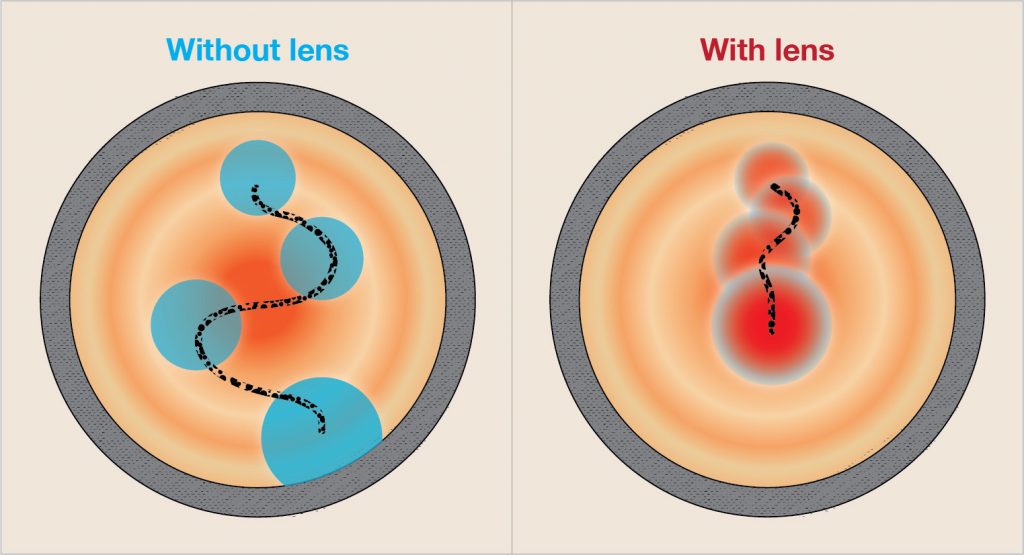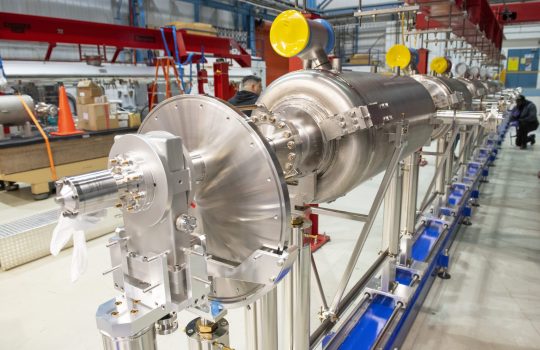Sending bunches of protons speeding around a circular particle collider to meet at one specific point is no easy feat. Many different collider components work keep proton beams on course — and to keep them from becoming unruly.
Scientists at Fermilab invented and developed one novel collider component 20 years ago: the electron lens. Electron lenses are beams of electrons formed into specific shapes that modify the motion of other particles — usually protons — that pass through them.
The now retired Tevatron, a circular collider at Fermilab, and the Relativistic Heavy Ion Collider (RHIC) at Brookhaven National Laboratory have both benefited from electron lenses, a concept originally developed at Fermilab.
“Electron lenses are like a Swiss Army knife for accelerators: They’re relatively simple and inexpensive, but they can be applied in a wide variety of ways,” said Alexander Valishev, a Fermilab scientist who co-authored a recent study for a new electron lens application, which could be crucial to forthcoming colliders.
The innovation is detailed in an article published on Sept. 27 in Physical Review Letters. (The article was also recently selected for presentation in the Physics Central’s Physics Buzz Blog.)
“This little breakthrough in the physics of beams and accelerators is kind of a beginning of a bigger invention — it’s a new thing,” said Fermilab’s Vladimir Shiltsev, an author of the published paper. Shiltsev also played a major role in the origination of electron lenses in 1997. “Fermilab is known for inventions and developments that are, first, exciting, and then, functional. That’s what national labs are built for, and that’s what we’ve achieved.”

An electron lens introduces differences in the movement of particles that constitute a particle bunch. In the illustration, the perspective is looking down the beam pipe — down the path of the particle bunch. The bunch is seen as approaching the viewer (as the circle increases in size). Left: the particle bunch, represented as a uniformly blue circle, contains particles that all behave in the same way. Because the constituent particles follow the exact same trajectory, the bunch is more susceptible to wild deviations from its path, resulting from electromagnetic wake-fields. Right: Treated by an electron lens, the particle bunch, represented by red and blue, contains particles that move slightly differently from one another. For example, particles closer to the interior of the bunch move differently from those closer to the outside. This variegation helps confine the particle bunch to the more desirable straightforward path. Illustration: Diana Brandonisio
A lens into the future
This new type of electron lens, called the Landau damping lens, will be a critical part of a huge, prospective project in particle physics research: the Future Circular Collider at CERN. The FCC would push the boundaries of traditional collider design to further study the particle physics beyond the Higgs boson, a fundamental particle discovered only five years ago.
The proposed FCC has to be a high-luminosity machine: Its particle beams will need to be compact and densely packed. Compared with CERN’s Large Hadron Collider, the beams will also have a dramatic increase in energy — 50 trillion electronvolts, compared with the LHC’s beam energy of 7 trillion electronvolts. That involves an equally dramatic increase in the size of the accelerator. With a planned circumference of 100 kilometers, the FCC would dwarf the 27-kilometer LHC.
These high-energy, high-luminosity supercolliders all experience a problem, regardless of size: An intense beam of protons packed into the width of human hair traveling over a long distance can become unstable, especially if all the protons travel in exactly the same way.
In a collider, particles arrive in packets called bunches — roughly foot-long streams packed with hundreds of billions of particles. A particle beam is formed of dozens, hundreds or thousands of these bunches.
Imagine a circular collider as a narrow racetrack, with protons in a bunch as a tight pack of racecars. A piece of debris suddenly appears in the middle of the track, disrupting the flow of traffic. If every car reacts in the same way, say, by veering sharply to the left, it could lead to a major pileup.
Inside the collider, it’s not a matter of avoiding just one bump on the track, but adjusting to numerous dynamic obstacles, causing the protons to change their course many times over. If an anomaly, such as a kink in the collider’s magnetic field, occurs unexpectedly, and if the protons in the beam all react to it in the same way at the same time, even a slight change of course could quickly go berserk.
One could avoid the problem by thinning the particle beam from the get-go. By using lower-density proton beams, you provide less opportunity for protons to go off course. But that would mean removing protons and so missing out on potential for scientific discovery.
Another, better way to address the problem is to introduce differences into the beam so that not all the protons in the bunches behave the same way.
To return to the racetrack: If the drivers all react to the piece of debris different ways —some moving slightly to the right, others slightly to the left, one brave driver just skips over the top — the cars can all merge back together and continue the race, no accidents.
Creating differentiations within a proton bunch would do essentially the same thing. Each proton follows its own, ever-so-slightly different course around the collider. This way, any departure from the course is isolated, rather than compounded by protons all misbehaving in concert, minimizing harmful beam oscillations.
“Particles at the center of the bunch will move differently than particles around the outside,” Shiltsev said. “The protons will all be kind of messed up, but that’s what we want. If they all move together, they become unstable.”
These differences are usually created with a special type of magnet called octupoles. The Tevatron, before its decommissioning in 2011, had 35 octupole magnets, and the LHC now has 336.
But as colliders get larger and achieve greater energies, they need exponentially higher numbers of magnets: The FCC will require more than 10,000 octupole magnets, each a meter long, to achieve the same beam-stabilizing results as previous colliders.
That many magnets take up a lot of space: as much as 10 of the FCC’s 100 kilometers.
“That seems ridiculous,” Shiltsev said. “We’re looking for a way to avoid that.”
The scientific community recognizes the Landau damping nonlinear lens as a likely solution to this problem: A single one-meter-long electron lens could replace all 10,000 octupole magnets and possibly do a better job keeping beams stable as they speed toward collision, without introducing any new problems.
“At CERN they’ve embraced the idea of this new electron lens type, and people there will be studying them in further detail for the FCC,” Valishev said. “Given what we know so far about the issues that the future colliders will face, this would be a device of extremely high criticality. This is why we’re excited.”
Electron Legos
The Landau damping lens will join two other electron lens types in the repertoire of tools physicists have to modify or control beams inside a collider.
“After many years of use, people are very happy with electron lenses: It’s one of the instruments used for modern accelerators, like magnets or superconducting cavities,” Shiltsev said. “Electron lenses are just one of the building blocks or Lego pieces.”
Electron lenses are a lot like Legos: Lego pieces are made of the same material and can be the same color, but a different shape determines how they can be used. Electron lenses are all made of clouds of electrons, shaped by magnetic fields. The shape of the lens dictates how the lens influences a beam of protons.
Scientists developed the first electron lens at Fermilab in 1997 for use to compensate for so-called beam-beam effects in the Tevatron, and a similar type of electron lens is still in use at the Brookhaven’s RHIC.
In circular colliders, particle beams pass by each other, going in opposing directions inside the collider until they are steered into a collision at specific points. As the beams buzz by one another, they exert a small force on each other, which causes the proton bunches to expand slightly, decreasing their luminosity.
That first electron lens, called the beam-beam compensation lens, was created to combat the interaction between the beams by squeezing them back to their original, compact state.
After the success of this electron lens type in the Tevatron, scientists realized that electron beams could be shaped a second way to create another type of electron lens.
Scientists designed the second lens to be shaped like a straw, allowing the proton beam to pass through the inside unaffected. The occasional proton might try to leave its group and stray from the center of the beam. In the LHC, losing even one-thousandth of the total number of protons in an uncontrolled way could be dangerous. The electron lens acts as a scraper, removing these rogue particles before they could damage the collider.
“It’s extremely important to have the ability to scrape these particles because their energy is enormous,” Shiltsev said. “Uncontrolled, they can drill holes, break magnets or produce radiation.”
Both types of electron lens have made their mark in collider design as part of the success of the Tevatron, RHIC and the LHC. The new Landau damping lens may help usher in the next generation of colliders.
“The electron lens is an example of something that was invented here at Fermilab 20 years ago,” Shiltsev said. “This is a one of the rare technologies that wasn’t just brought to perfection at Fermilab: It was invented, developed and perfected and still continues to shine.”



